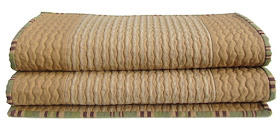That's because, way back when, when mattresses were stuffed with either feathers or straw, ticking was created and used as mattress fabric. It's close, tight weave and sturdiness was necessary in order to keep the pointy ends of feather shafts, or the ends of straw, from poking through the mattress and into the persons skin!
Follow
Wednesday, November 21, 2012
Tickled with Ticking
That's because, way back when, when mattresses were stuffed with either feathers or straw, ticking was created and used as mattress fabric. It's close, tight weave and sturdiness was necessary in order to keep the pointy ends of feather shafts, or the ends of straw, from poking through the mattress and into the persons skin!
15 comments:
Please know that I read, and truly appreciate each and every comment! Thank you for taking the time to let me know what you think. While time restrictions prevent me from being able to respond personally to every comment, please know that if you ask me a specific question concerning a technique, etc., I will do my best to respond in my comment section, so be sure to check back!
PRIVACY & COOKIES:
This site is powered by Blogger which is owned by Google and thus uses cookies. By continuing to use this website, you agree to their use. I personally do not collect, share or store any personal information about you. Please note that when you leave a comment, your name may be visible to myself and others who visit this site and may be linked back to you, thus providing myself and others who visit this blog an ability to connect with you through profiles that you have set up and information that you have made public. You can find more information on how Google collects information in their privacy policy found here: https://policies.google.com/privacy?hl=en&gl=us










Happy Thanksgiving Victoria. The tickinh table runners are awesome. Love the quilting and the appliqued pieces!
ReplyDeleteI love ticking too. Thanks for such an interesting post!
ReplyDeleteYou make the most beautiful tablerunners I've seen - simple and elegant. I'm curious, your stitching is so consistent, do you quilt the wavy lines using free motion techniques, or do you use a walking foot, perhaps a wavy line decorative stitch? Thanks for the inspiration!
ReplyDeleteLike you, I love ticking - and I love what you've done with it here! :)
ReplyDeleteVictoria, you certainly have a God given gift for making quilts and such. Thank you for sharing.
ReplyDeleteHappy Thanksgiving.
blessings, jill
Simply beautiful!
ReplyDeleteThese look ever so soft and gentle. Love the wavy quilting with the stripes!
ReplyDeleteHappy Thanksgiving to you, Victoria!
so lovely!
ReplyDeleteYour quilting is so perfect! How do you do it? I think your work is my favorite of all the quilters that I see! I love those lines!!
ReplyDeleteThanks to each of you!
ReplyDeleteKay and Kate, all the quilting shown on these runners was done using a walking foot. I use the edge of the walking foot to help guide my spacing, and I also use the stripes on the fabric to help guide me.
For straight stitching I usually set my stitch length a bit longer then the default setting - I like to set it between 3 and 3.5. I find elongating it just that extra bit creates a better machine quilted line.
As for the wavy quilt lines, they are actually done with a decorative stitch on my sewing machine that looks like a zig-zag stitch with curved points, instead of pointy points... if that makes sense! (It doesn't have a specific name in my manual, and is just listed as a "decorative stitch"). By elongating the length and playing with the width settings, I can make various elongated wavy lines. (I discovered this by pure accident one day when my hand accidentally bumped the length setting while I was using this particular decorative stitch!) Try playing around with your decorative stitches, adjusting widths and lengths, and see what you may have! :)
So soft and pretty.
ReplyDeleteYou photograph them so beautifully, too.
ReplyDeleteI love these runners, your quilting is top notch!
ReplyDeleteAbsolutely beautiful! So glad I found your blog.
ReplyDeletei really like the one with the patches
ReplyDelete